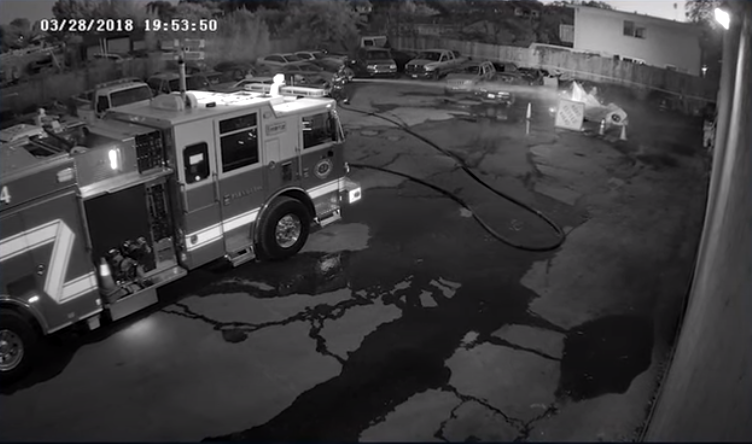Three out of four of the electric vehicle battery fires they investigated reignited in the towing storage facility. Safety recommendations say vehicles should be separated by 50 feet when stored or separated by physical barriers from other vehicles.
The National Transportation Safety Board issued four safety recommendations yesterday based on findings contained in Safety Report 20/01 which documents the agency’s investigation of four electric vehicle fires involving high-voltage, lithium-ion battery fires.
Of concern for the collision repair and towing industry is that the NTSB found that three out of four of the electric vehicle battery fires they investigated reignited in the towing storage facility.

The NTSB video summary of its report showed CCTV footage of firefighters putting out a battery fire that reignited in a towing company’s storage yard in Mountain View, Calif.
Three of the lithium-ion batteries that ignited were damaged in high-speed, high-severity crashes, and the fourth lithium-ion battery fire occurred during normal vehicle operations. All three of the crash-damaged batteries reignited after firefighters extinguished the vehicle fires. The battery in the fourth investigation did not reignite.
Safety issues with the high-voltage, lithium-ion batteries used in electric vehicles first gained widespread attention when a Chevrolet Volt caught fire three weeks after a crash test in May 2011.
The video embedded below summarizes the report released by the NTSB yesterday.
Fires in electric vehicles powered by high-voltage lithium-ion batteries pose the risk of electric shock to emergency responders from exposure to the high-voltage components of a damaged lithium-ion battery. A further risk is that damaged cells in the battery can experience thermal runaway – uncontrolled increases in temperature and pressure – which can lead to battery reignition. The risks of electric shock and battery reignition/fire arise from the “stranded” energy that remains in a damaged battery.
According to the NTSB report, ” Firefighters who participate in the initial emergency response and tow truck drivers who move a damaged electric vehicle from the scene can all be exposed to the risks of stranded energy. Storing an electric vehicle with a damaged high-voltage lithium-ion battery is an additional problem.”
The battery fires investigated by the NTSB reignited multiple times, even days after a crash, placing other vehicles and nearby structures at risk for fire. The Chevrolet Volt that reignited 3 weeks after a crash test damaged four nearby vehicles.
According to the NTSB report, the National Fire Protection Association (NFPA) and vehicle manufacturers recommend leaving a 50-foot clearance around a stored, damaged electric vehicle to prevent fire damage to nearby vehicles or structures in case the battery reignites.
Guidance in SAE J2990 gives an alternate solution: create a barrier of earth, steel, concrete, or solid masonry around the vehicle.
The report raised issues with vehicle manufacturer guidance documents on the safety risks stating, “The guidance documents generally limit their advice to calling the manufacturer for instructions or leaving at least 50 feet of clearance around the vehicle. The NTSB considers that advice impractical at best. Given the SAE’s recommendation to also consider isolating a damaged electric vehicle inside a barrier of earth, steel, concrete, or masonry, manufacturers might consider including such an alternative in their guidance.”
In the report, the NTSB also urges vehicle manufacturers to include in their emergency response guides information specific to each vehicle so that firefighters and tow truck drivers can efficiently and safely act in emergencies involving electric vehicles that are powered by high-voltage lithium-ion batteries.
Safety Report 20/01 identified two main safety issues through its investigation:
- The inadequacy of vehicle manufacturers’ emergency response guides.
- The gaps in safety standards and research related to high-voltage lithium-ion batteries involved in high-speed, high-severity crashes.
Actions sought by the NTSB in the four safety recommendations issued Wednesday include:
- Factoring the availability of a manufacturer’s emergency response guide, and its adherence to International Organization for Standardization standard 17840 and SAE International recommended practice J2990, when determining a U.S. New Car Assessment Program score.
- Continued research on ways to mitigate or deenergize stranded energy in high-voltage lithium-ion batteries.
- Continued research on ways to reduce the hazards associated with thermal runaway resulting from high-speed, high-severity crashes.
- Manufacturer emergency response guides modeled on ISO standard 17840 and SAE International recommended practice J2990.
- Incorporation of vehicle-specific information in emergency response guides for:
- Fighting high-voltage lithium-ion battery fires.
- Mitigating thermal runaway and the risk of high-voltage lithium-ion battery reignition.
- Mitigating risks associated with stranded energy in high-voltage lithium-ion batteries during emergency response and before a damaged electric vehicle is removed from the scene.
- Safely storing an electric vehicle with a damaged high-voltage lithium-ion battery.
- Providing information and available guidance to first responders and other crash scene workers about fire risks associated with high-voltage lithium-ion battery fires in electric vehicles.